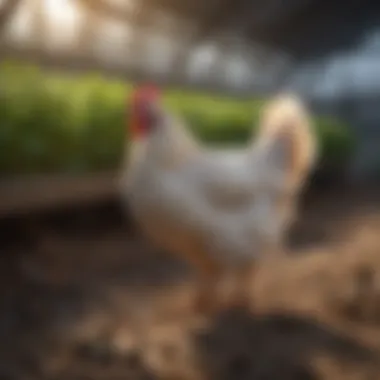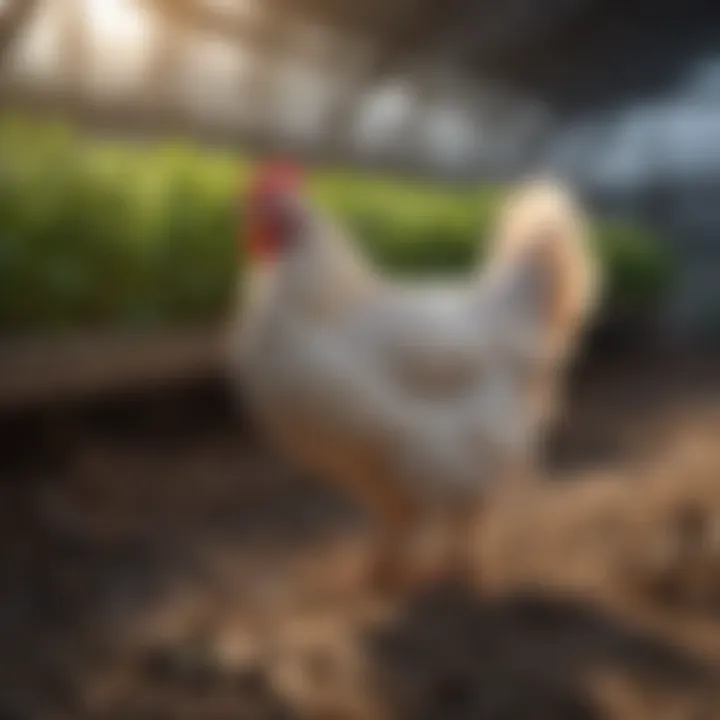Lab Grown Chicken Breast: Future of Sustainable Meat


Intro
Lab grown chicken breast represents a significant advancement in food technology, addressing some of the pressing challenges faced by traditional meat production. With rising concerns about environmental sustainability, animal welfare, and food security, the exploration of lab grown meat becomes imperative. This article delves into multiple facets of lab grown chicken, from its production techniques to its nutritional profile and market prospects.
Topic Overview
Definition and Importance
Lab grown chicken breast, also known as cultured meat, refers to meat produced by cultivating animal cells in a controlled environment, without the need to raise and slaughter live animals. This innovative approach is crucial as it aims to reduce the environmental impact of meat production and improve animal welfare standards. By 2030, the demand for meat is expected to rise substantially, intensifying the need for sustainable alternatives.
Brief History and Evolution
The concept of culturing meat cells has evolved over several decades. Initial experiments can be traced back to the early 20th century, but significant breakthroughs occurred in the 21st century. In 2013, the first lab grown burger was unveiled, bringing public attention to this technology. Since then, multiple companies such as Memphis Meats and JUST have pursued the commercialization of lab grown chicken and other meats. This history shows not only the potential for innovation but also the urgency of transitioning towards sustainable food sources.
Key Techniques and Innovations
Sustainable Farming Practices
Utilizing lab grown methodologies reduces reliance on conventional farming, which often contributes to land degradation, deforestation, and excessive water use. The production of lab grown chicken requires less land and water, significantly minimizing the carbon footprint associated with meat production. Key practices include the use of biodegradable materials and energy-efficient bioreactors to enhance sustainability.
Advanced Agronomic Technologies
Several technological advancements play a pivotal role in the production of lab grown chicken. This includes:
- Bioreactor Systems: These systems facilitate optimal growth conditions for muscle cells, allowing them to proliferate and form tissue.
- Cell-Culture Techniques: Scientists utilize stem cell technology to cultivate muscle cells efficiently, mimicking the natural growth process found in live animals.
- Nutrient Optimization: Nutrients are carefully formulated to provide the essential needs for cell growth, ensuring high-quality meat production.
Practical Applications
Step-by-Step Guides
Producing lab grown chicken breast involves a series of precise steps:
- Cell Selection: Scientists select appropriate animal cells for cultivation.
- Culturing Cells: Cells are placed in a controlled environment with nutrients and conditions that promote growth.
- Tissue Engineering: Techniques are applied to develop tissue structures that resemble traditional meat.
- Harvesting: After appropriate growth, the cultured meat is harvested for processing and distribution.
Case Studies or Real-World Examples
Various companies are making strides in bringing lab grown chicken to market. For instance, GOOD Meat, based in California, is recognized for its innovative processes that yield chicken without the need for animal husbandry. Their commitment to quality and sustainability has garnered significant attention from consumers and investors alike.
"Cultured meat transforms how we think about food production and consumption, heralding a new era of sustainable practices."
Through these various sections, this article will provide a foundation for understanding the complexities and potentials of lab grown chicken breast, paving the way for informed discussions about the future of food.
Prelims to Lab Grown Chicken Breast
The emergence of lab grown chicken breast marks a significant milestone in the intersection of technology and food production. This innovative approach to meat production involves cultivating chicken cells in a controlled environment, rather than raising live birds. One of the main advantages is the potential for reducing the environmental impact associated with traditional poultry farming. Lab grown meat occupies an important space in discussions about sustainability in agriculture, especially as concerns about climate change and animal welfare grow.
In recent years, the demand for sustainable food sources has surged. Consumers in many regions prefer options that do not contribute to deforestation or greenhouse gas emissions. Lab grown chicken breast could satisfy this demand while also offering a more humane alternative to conventional meat production. Moreover, the ability to produce meat without the need for animal husbandry presents a remarkable approach to addressing global food security concerns.
Additionally, this field represents a confluence of innovation, ethics, and economics. The ongoing advancements in cellular agriculture technology promise efficiencies that may not be achievable in traditional practice. Understanding the production processes and the various components of lab grown chicken is crucial, not only for potential consumers but also for stakeholders in agriculture looking to adapt to changing consumer preferences and regulations.
This section sets the stage for a comprehensive dialogue about lab grown chicken breast, which is an increasingly relevant subject within the modern agricultural context. As we progress through this article, we will delve into the science behind cultured meat, explore its nutritional attributes, evaluate its environmental implications, and consider its economic viability in today’s market.
The Science of Cultured Meat
The field of cultured meat, specifically lab grown chicken breast, represents a transformative shift in the food industry. The science behind this innovation is critical not just for its technological implications but also for addressing pressing issues like sustainability and food security. Understanding the basic science allows for a deeper insight into how lab grown meat can potentially revolutionize traditional agriculture and minimize its environmental footprint.
Defining Lab Grown Meat
Lab grown meat refers to meat products that are produced by cultivating animal cells outside of an animal's body. Unlike conventional meat, which requires the raising and slaughtering of livestock, lab grown meat offers a more humane and sustainable way to meet global protein demands. The stem cells from chickens are extracted and then differentiated into muscle tissue in a controlled environment. This reduces the resources and land traditionally required for meat production.
Cellular Agriculture Explained
Cellular agriculture is the framework through which lab grown meat is developed. It utilizes techniques from tissue engineering and cellular biology to produce edible tissues. The concept hinges on the idea that muscle cells can grow in vitro rather than in a live animal. This approach holds great promise for creating a more sustainable food supply while also catering to the ethical concerns associated with livestock farming.


Methods in Cultivating Chicken Cells
Bioreactor Technology
Bioreactor technology is a cornerstone of the production of lab grown chicken breast. These systems provide a regulated environment where chicken cells can proliferate and develop. A key characteristic of bioreactors is their ability to control variables such as temperature, pH, and nutrients, which are crucial for optimal cell growth. This technology allows for high efficiency and scalability in production. However, one challenge is maintaining consistent quality of the product due to varying cell responses in different bioreactor conditions.
Nutrient Medium Composition
Nutrient medium composition is vital to the cultivation process. The medium provides the necessary nutrients that chicken cells require for growth. It typically contains amino acids, vitamins, and glucose, which serve as the building blocks for cell proliferation. A significant advantage of a well-defined medium is the potential for modifying its composition for fortification—enhancing the nutritional profile of the final product. The development of cost-effective media remains a challenge, as specialized ingredients can increase production costs.
Scaffold Structures
Scaffold structures play an important role in simulating the natural environment of muscle tissue. They provide support for the cells to adhere and grow, mimicking the extracellular matrix found in living organisms. This characteristic is beneficial because it helps create a finalized product that resembles traditional meat not just in taste but also in texture. However, the choice of scaffolding material impacts the sensory qualities of the meat, and finding optimal materials is an ongoing area of research.
Nutritional Overview of Lab Grown Chicken Breast
Understanding the nutritional overview of lab grown chicken breast is essential to grasp its potential role in modern diets. As consumers become more health-conscious, the nutritional profile of any food product plays a significant part in its acceptance. Lab grown chicken, derived from cultured cells, aims to mimic the traditional poultry's qualities while offering potential enhancements.
Both the composition and benefits of lab grown chicken breast are paramount to discussing its place in diets. Concerns about antibiotic use, hormonal injections, and chemicals in traditional meat production often push consumers towards alternative sources. Lab grown chicken presents an opportunity to address these issues while ensuring nutritional adequacy.
Comparative Nutritional Profiles
When assessing lab grown chicken against conventional chicken, it is crucial to focus on macronutrients and micronutrients. In general, lab grown chicken aims to provide similar protein levels with fewer unwanted substances. Here are some highlighted points:
- Protein Content: Lab grown chicken is expected to have a high protein concentration equivalent to that of conventional chicken. Given the technological advancements, some variations even exceed the traditional sources, providing a well-rounded amino acid profile.
- Fat Composition: Researchers can manipulate the fat content in lab-grown varieties, potentially allowing for healthier unsaturated fats instead of saturated fats found in traditional poultry.
- Vitamins and Minerals: With controlled environments for growth, lab grown chicken can be engineered to be rich in essential vitamins such as B12, and minerals like iron.
A significant advantage of lab grown meat is it does not require feed animals, in contrast to traditional chicken farming which consumes vast resources. Thus, lab grown chicken may emerge as an efficient protein source with favorable nutritional implications.
Possibility of Fortification
The fortification of lab grown chicken breast represents an innovative method for enhancing its nutritional value. By precisely controlling the nutrient inputs during the cell cultivation process, manufacturers have the opportunity to enrich the final product beyond its natural capabilities.
Key points regarding fortification include:
- Customized Nutrients: Nutrients like omega-3 fatty acids or additional vitamins can be integrated into the production phase, targeting specific health benefits based on consumer needs.
- Addressing Deficiencies: In populations where nutrient deficiencies are prevalent, fortified lab grown chicken could play a significant role in improving public health outcomes.
- Consumer Preferences: As the market for health-conscious products grows, fortified lab grown chicken may attract a specific demographic, promoting healthier eating habits.
"The design of lab grown chicken allows for tailored nutritional profiles, which could help in combating dietary deficiencies in various populations."
Environmental Impact Assessment
The importance of an Environmental Impact Assessment in the context of lab grown chicken breast lies in its ability to provide insights into the sustainability of this innovative food source. Traditional meat production is often criticized for its environmental footprint, including land use, water consumption, and greenhouse gas emissions. By analyzing the environmental implications of lab grown chicken, we can assess its potential benefits and drawbacks compared to conventional meat production.
This assessment not only explores the ecological ramifications but also supports informed decision-making among consumers, investors, and policymakers. Understanding the ecological benefits of cultured meat can pave the way for broader acceptance and integration into our food systems as a viable alternative to conventional meat.
Resource Efficiency
Lab grown chicken breast presents a significant opportunity for resource efficiency. In traditional poultry farming, vast quantities of land, feed, water, and energy are required to raise livestock. In contrast, lab grown methods use cellular agriculture to cultivate chicken cells with far less resource expenditure.
Using bioreactors, scientists can create optimal growth conditions. The resources used in producing lab grown meat can be considerably lower, as this method circumvents the need for raising and feeding live animals. Emphasizing resource efficiency helps outline how lab grown chicken can be part of a solution to enhance food security while minimizing environmental burdens.
Carbon Footprint Implications
The carbon footprint of lab grown chicken is an essential factor to consider. Conventional meat production contributes significantly to greenhouse gas emissions, primarily through methane production from livestock and carbon emissions linked to feed cultivation and transport. Lab grown meat, however, potentially offers a reduced carbon footprint.
Studies suggest that cultured meat production could lead to fewer overall emissions. This is due to less energy-intensive processes needed for cultivation compared to conventional meat systems. As technological advancements continue to improve the efficiency of lab grown meat production, this aspect could play a key role in climate change discussions. Thus, evaluating carbon footprint implications highlights a pathway for more sustainable food production practices.
Water Usage Comparison
Water usage is another critical aspect of the environmental impact assessment. Traditional chicken farming requires substantial water resources for drinking, cleaning, and growing feed crops. In contrast, lab grown chicken systems could significantly reduce water consumption.
The cultivation of cells in bioreactors uses water more efficiently than conventional processes. Research indicates that lab grown chicken may require up to 95% less water than traditional meat production. This reduction could alleviate some of the pressures on global freshwater resources, supporting a more sustainable approach to food production.
"Water scarcity is an increasing global concern; shifting to lab grown proteins can help mitigate this issue considerably."


Addressing water usage comparisons underscores the environmental benefits that lab grown chicken breast may provide. By advancing lab grown meat technologies, we may take significant steps toward more sustainable food systems, positively influencing future generations.
Economic Considerations
Economic factors play a crucial role in the development and acceptance of lab grown chicken breast. Understanding these factors is essential not just for producers, but also for consumers and policymakers interested in the future of food. This section will explore the cost of production, market viability, and investment trends related to cultured meat.
Cost of Production
The cost of producing lab grown chicken breast has been a significant barrier to its market introduction. Initially, the production process was expensive, primarily due to the technology and resources required. However, as research continues and technology evolves, costs are gradually decreasing.
Several components contribute to the cost of production. These include:
- Bioreactor expenses: The apparatus used to cultivate cells can be costly. It must provide optimal conditions for growth, which adds to the overall expenses.
- Nutrient mediums: The formulations used to sustain cell growth are intricate and often expensive. Optimizing these mediums can enhance growth rates but also impact costs.
- Labor and infrastructure: Skilled personnel and specialized facilities are required, which further increases initial investment.
As production methods improve, there is potential for costs to reduce significantly, making lab grown chicken more accessible to consumers.
Market Viability
The viability of lab grown chicken in the market depends on consumer acceptance, pricing strategies, and competition with traditional meat sources. Consumer attitudes towards lab grown meat are evolving, reflected in increasing interest for sustainable and ethical food choices.
Several factors influence market viability:
- Pricing: If lab grown chicken can reach price parity with conventional chicken, it is more likely to succeed in the market.
- Consumer education: Educating consumers about the benefits of lab grown chicken can improve acceptance. Knowledge about its nutritional benefits and environmental impact is key.
- Distribution channels: Establishing efficient distribution can enhance availability in grocery stores and restaurants, driving consumer trial and adoption.
Investment Trends in Cultured Meat
Investment in cultivated meat is gaining momentum, signaling strong belief in the technology's potential. Numerous companies and startups are developing innovative products and methods, attracting venture capital and other forms of investment.
Key trends include:
- Increased venture capital funding: With the growing interest in sustainability, more investors are keen on supporting lab grown meat projects, believing they are future-oriented solutions to food production.
- Collaborations and partnerships: Companies are forming partnerships with research institutions to enhance technological advances and penetration into the market.
- Government interest: Some governments are recognizing the potential of lab grown meat to address food security issues and sustainability, leading to increased funding and support for research.
Regulatory Landscape
The regulatory landscape surrounding lab grown chicken breast is critical in understanding its future viability and acceptance in the market. As this technology evolves, regulatory frameworks must also adapt to ensure safety, transparency, and consumer trust. Lab grown meat offers promising advantages but also raises unique concerns that must be assessed by regulatory authorities. Understanding these elements is key for stakeholders involved in its production and marketing.
Approval Processes for Cultured Meat
The approval processes for lab grown meat vary across regions, influenced by local regulations and safety standards. In the United States, the process is primarily overseen by the Food and Drug Administration (FDA) and the Department of Agriculture (USDA). Before lab grown meat can be sold, producers are required to submit detailed reports outlining safety data, production methods, and ingredient specifications. These comprehensive submissions undergo rigorous assessment to ensure that the meat is safe for consumption.
Countries like Singapore have established a quicker pathway for approval. Singapore became the first country to approve the sale of lab grown chicken products, specifically the cultured chicken bites developed by Eat Just. This shows that approval processes can be streamlined in supportive regulatory environments, promoting innovation in food technology.
Labeling and Marketing Considerations
Labeling and marketing of lab grown chicken is another crucial aspect to consider. Clear labeling can help consumers make informed choices and understand what they are buying. However, the terminology used in marketing cannot mislead consumers about the product's nature. Regulatory bodies typically require that the labeling accurately describes the contents and production methods used to create the product.
There may be debates concerning the use of terms such as "lab grown" or "cultured meat" versus "artificial" meat. These distinctions can influence public perception and acceptance. Thus, the language employed in marketing is paramount, as it must resonate with consumers while conforming to regulations. Public acceptance is vital for market success, and effective communication around these products can aid in dispelling any misconceptions.
"Transparency in labeling is essential for fostering trust between producers and consumers, especially in innovative fields like lab grown meat."
As the market for lab grown chicken continues to evolve, aligning regulatory practices with consumer expectations will be essential. Stakeholders must remain conscious of these dynamics to successfully navigate the complex landscape of regulations.
Public Perception and Acceptance
The public perception and acceptance of lab grown chicken breast are crucial elements influencing its success. As this innovative meat alternative enters the market, understanding the mindset of consumers is essential. Many factors contribute to whether people embrace lab grown meat. These include familiarity with the product, knowledge about its production processes, health concerns, and cultural beliefs. Each of these considerations can shape consumer attitudes significantly.
Consumer Attitudes Toward Lab Grown Meat
Research shows mixed feelings regarding lab grown meat. Some consumers view it as a sustainable and ethical alternative to traditional meat. The ability to produce meat without raising animals appeals to individuals concerned about animal welfare. However, there are skeptics who harbor doubts about the safety and nutritional value of lab grown meat.
Surveys indicate that younger consumers tend to be more open to trying lab grown chicken. They often prioritize sustainability and environmental concerns. In contrast, older generations may prefer traditional meat due to familiarity. This generation gap in acceptance signals a need for targeted outreach that addresses various demographic preferences.
Key Factors Influencing Consumer Attitudes:


- Sustainability: Many see lab grown meat as a solution to overfishing and deforestation associated with livestock farming.
- Health Concerns: Some consumers worry about potential additives and the long-term effects of consuming lab grown products.
- Taste and Quality: The perception that lab grown meat may not taste as good as conventional options can deter interest.
Cultural Considerations
Cultural perceptions play a significant role in the acceptance of lab grown chicken. Food traditions vary widely across societies. In some cultures, meat consumption is deeply ingrained and linked to heritage. This emotional connection can lead to resistance against new food technologies, including lab grown alternatives.
Different cultural attitudes toward technology and innovation also affect acceptance. Regions more accustomed to biotechnology may embrace lab grown chicken, viewing it as an advancement in food science. Alternatively, places where traditional practices dominate may be more reluctant. The messaging used in marketing lab grown chicken can also impact how it is perceived within various cultural contexts.
As consumer awareness grows, discussions surrounding lab grown meat are likely to evolve. Public education campaigns are vital to explain the benefits, address concerns, and dispel myths. Engaging with communities to understand their perspectives can help develop products tailored for different cultural groups.
Understanding public perception is key to the success of lab grown chicken in the market.
Overall, public perception and acceptance are dynamic factors that will shape the future of lab grown chicken. Addressing concerns and educating consumers about its benefits could lead to broader acceptance.
One must remember that acceptance is a gradual process, informed by cultural, social, and economic changes. As these elements shift, so too may the public’s attitude toward lab grown chicken.
Comparison with Traditional Meat Production
The comparison between lab grown chicken breast and traditional meat production is a significant topic in the conversation surrounding modern agriculture and food sustainability. As the global population continues to rise, the demand for protein sources has also increased. Traditional meat production, primarily dependent on raising livestock, brings forth various challenges, including environmental degradation, animal welfare concerns, and inefficiencies in resource usage. In contrast, lab grown chicken offers a potential alternative that addresses many of these issues.
Nutritional Benefits and Risks
Lab grown chicken breast is often touted for its nutritional advantages. Unlike traditional meat, the cultivation of lab grown chicken allows for precision in nutrient composition. It can be designed to have lower fat content while maintaining high protein levels, making it favorable for health-conscious consumers. Higher omega-3 fatty acids can potentially be introduced through the fortification of the nutrient media utilized during the production process. Additionally, lab grown meat is free from antibiotics and hormones, which are commonly used in traditional poultry farming.
However, some risks are also associated with lab grown chicken. There are concerns regarding the long-term health impacts of consuming cultured meat. As it is a relatively new technology, comprehensive studies on its long-term effects are still lacking. Consumers may also be skeptical about the safety of the production processes, which may affect market acceptance.
In summary, while lab grown chicken breast presents notable nutritional benefits, the associated risks warrant careful consideration and further research.
Sustainability and Ethical Considerations
When looking closely at sustainability, lab grown chicken represents a significant breakthrough. Traditional poultry farming requires vast amounts of land, water, and feed. The resources needed for rearing chickens significantly contribute to deforestation and carbon emissions. In comparison, lab grown chicken has the potential to reduce these resource demands dramatically. Studies show that cultivated meat can use 70% less land and produce up to 96% lower greenhouse gas emissions compared to conventional chicken farming.
From an ethical standpoint, lab grown chicken does not require the raising and slaughtering of animals. This aspect addresses animal welfare concerns that traditional meat production faces. Reducing the need for animal farming might lead to less exploitation and suffering of animals.
"Cultured meat has the potential to reshape our understanding and interaction with food production, paving the way for a more sustainable and ethical future."
Despite these benefits, ethical challenges remain. Concerns about the monopolization of technology, and the implications of industrialized food systems, still pose risks. In addition, not all cultured meat companies maintain the same commitment to ethical practices, leading to varying levels of sustainability in the market.
Overall, comparing lab grown chicken to traditional meat shows promising sustainability potential and ethical advantages, but ongoing vigilance is necessary. These elements highlight why this comparison is crucial in understanding the role lab grown chicken may play in our food system and the broader context of agricultural practices.
Future Prospects for Lab Grown Chicken
The future of lab grown chicken presents a significant area of interest for those involved in agriculture and food production. This innovative sector aims to address many pressing issues, such as food security, ethical considerations, and environmental sustainability. As technological advancements continue to unfold, the landscape of cultured meat will likely transform.
Technological Innovations Anticipated
Technological progress plays a vital role in the development of lab grown chicken. Researchers are exploring various avenues that could enhance production efficiency and reduce costs. Some anticipated innovations include:
- Advanced Cell Culturing Techniques: New methods may significantly improve cell growth rates, making the production process more efficient.
- Improved Nutrient Media: Ongoing research into optimizing the composition of nutrient media could lead to enhanced yields and better nutritional profiles.
- Bioreactor Developments: Innovations in bioreactor designs may help streamline the scaling up process from lab to commercial production.
Collectively, these advancements could lead to a higher quality and lower cost product, making lab grown chicken more accessible to a wider audience.
Predicted Market Trends
The market for lab grown chicken is expected to expand considerably in the coming years. Factors contributing to this growth include:
- Consumer Demand for Alternatives: As more consumers seek sustainable options, the demand for lab grown meat could see a marked increase.
- Investment in Startups: Numerous companies are entering this space, leading to a competitive market environment that facilitates innovation and cost reduction.
- Changing Regulatory Frameworks: As governments adapt to the emergence of lab grown meat, clearer regulations might enable quicker approval processes and foster consumer trust.
The anticipated growth in the lab grown chicken market aligns with broader shifts in consumer preferences toward sustainability and health-conscious eating.
Ending
The conclusion of this article delves into the multifaceted importance of lab grown chicken breast. This revolutionary approach to meat production not only has the potential to reshape the landscape of food consumption but also holds significant implications for sustainable agricultural practices.
The primary benefit of lab grown chicken lies in its ability to minimize the detrimental impacts traditionally associated with conventional meat production. As highlighted earlier, factors such as land use, water consumption, and carbon emissions are critical in assessing agricultural sustainability. By shifting towards cellular agriculture, these environmental burdens can be substantially reduced.
Additionally, lab grown chicken has the potential to address public health concerns related to the consumption of meat. The controlled environment of cellular agriculture allows for greater oversight over nutritional profiles, enabling the possibility of fortifying meat products with essential nutrients. This advancement could improve dietary options, especially in regions experiencing food insecurity.
Furthermore, the economic viability of lab grown chicken is not to be underestimated. As technology continues to advance, production costs are expected to decrease, making lab grown meat more accessible to the general public. This shift can stimulate investment in the sector and drive competition among producers, fostering innovation and potentially leading to a more robust market.
"Lab grown meat presents an innovative solution to some of the most pressing issues in food production today."



